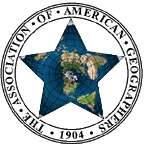Introduction
This lesson serves two purposes. First, it completes the discussion of national security aspects of geospatial intelligence by focusing on the evolution of military applications of geographic technology. Second it allows us to critically examine a contemporary case study of the role of geospatial intelligence in warfare.
Geographic techniques have supported warfare since shortly after Cain slew Abel and mapped out his next moves. Cartographers provided increasingly sophisticated maps to support military activities, while military demand spurred the development of the discipline. This symbiotic relationship between geographic techniques and military activities was very evident in the development of the sub-disciplines and technologies of remote sensing and global positioning systems. It is somewhat less evident in the development of Geographic Information Systems (or is it?)
 The American Association of Geographers commissioned two books to celebrate the centennial of the organization in 2004. These books were given as gifts to each of the 5,000 participants in that year's annual meeting in Philadelphia, PA. I was asked to contribute a chapter on military applications of geographic technology. Just after finishing the draft chapter, my Army Reserve Unit was mobilized on 10 February 2003. As is usually the case, there were some revisions required, but I was somewhat busy invading Iraq. Fortunately, my friend and colleague COL Eugene Palka (Head of Geography and Environmental Engineering at the US Military Academy at West Point, NY) stepped in to improve and finish the chapter. It was my honor to have him as my co-author and I thank him for stepping in to save the day (and make it a better chapter).
The American Association of Geographers commissioned two books to celebrate the centennial of the organization in 2004. These books were given as gifts to each of the 5,000 participants in that year's annual meeting in Philadelphia, PA. I was asked to contribute a chapter on military applications of geographic technology. Just after finishing the draft chapter, my Army Reserve Unit was mobilized on 10 February 2003. As is usually the case, there were some revisions required, but I was somewhat busy invading Iraq. Fortunately, my friend and colleague COL Eugene Palka (Head of Geography and Environmental Engineering at the US Military Academy at West Point, NY) stepped in to improve and finish the chapter. It was my honor to have him as my co-author and I thank him for stepping in to save the day (and make it a better chapter).
The chapter you will read is based entirely on open source documents. The sections on current national technical systems were based on open source information from the Federation of American Scientists. Some of the GEOINT practitioners may role their eyes at inaccuracies. If there are any-do not tell us. For our purposes this is the best information we have and all we need to know.
The chapter is a history of the evolution of geographic technologies and their contributions to military activities. The chapter also contends that geographic technologies fundamentally underpin the so called "Revolution in Military Affairs" (RMA). This is a very debatable point and we will have some fun doing just that. The RMA concept is somewhat out of favor in military academic circles but a major discussion is under way concerning the related concept of "Network Centric Warfare." I will ask you to consider NCW and how it relates to geospatial intelligence.
We also want to look at current events to provide us with a case study of how GEOINT has for better or worse been used in Operations Enduring Freedom (Afghanistan) (OEF), Operation Iraqi Freedom (OIF), and in a larger sense The Long War (formerly The Global War on Terrorism or GWOT). For Background on OIF you will read an article that looks at OIF through the lens of military geography. You will then look at a number of application articles from the National Geospatial-Information Agency's Pathfinder magazine that address NGA contributions to OEF and OIF. We will also briefly consider the role of intelligence in the Long War based on current and previous readings.
Our final topic on future applications of GEOINT is actually up to the students. This will be a major topic for you to educate me and your classmates on future applications based on your research and experience.
Remember that we have set up a Webliography page in ANGEL for everyone to use. If you find some sites that you think other people in the class might find useful, coinsider adding the URL to the class "Webliography". (See panel below.)